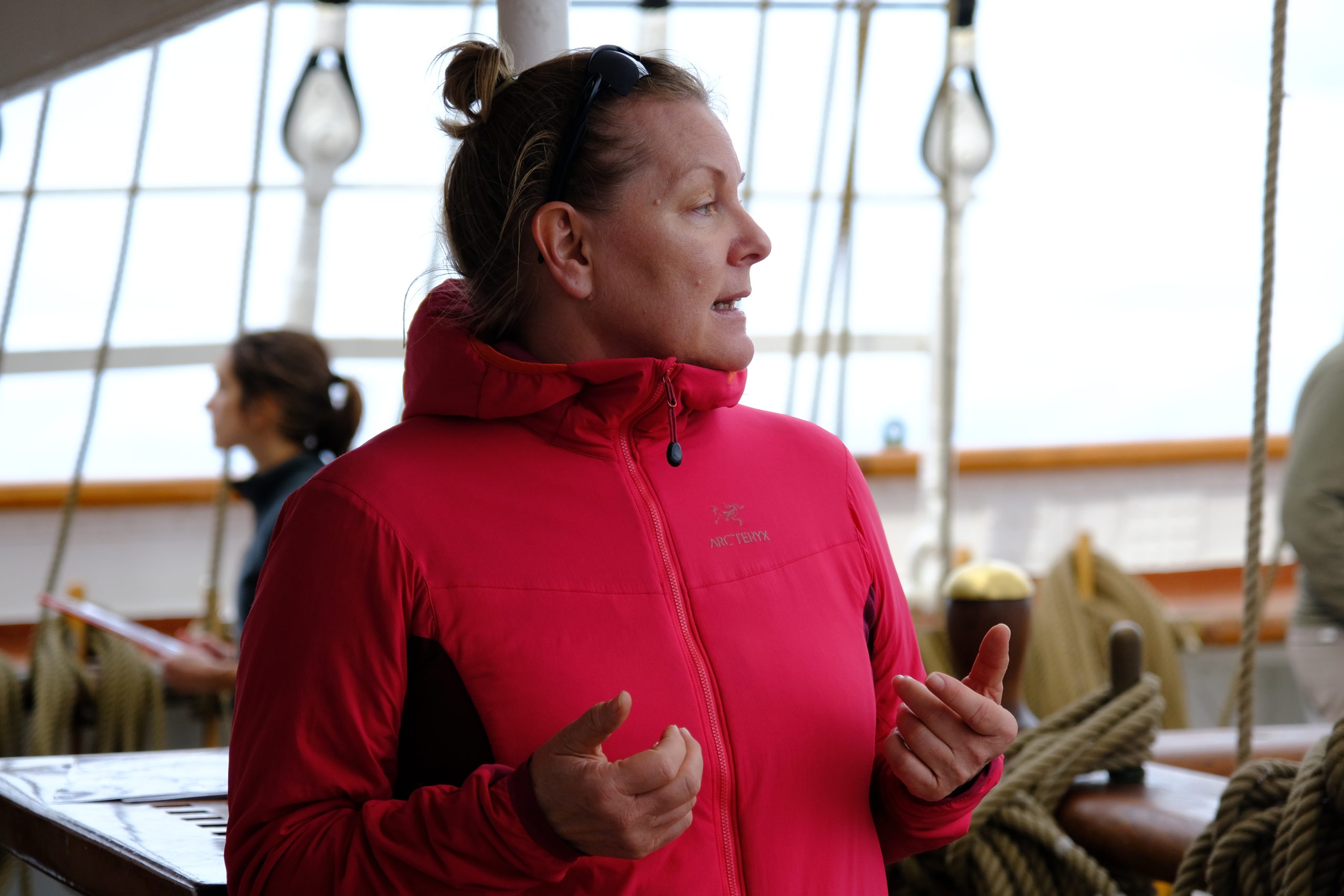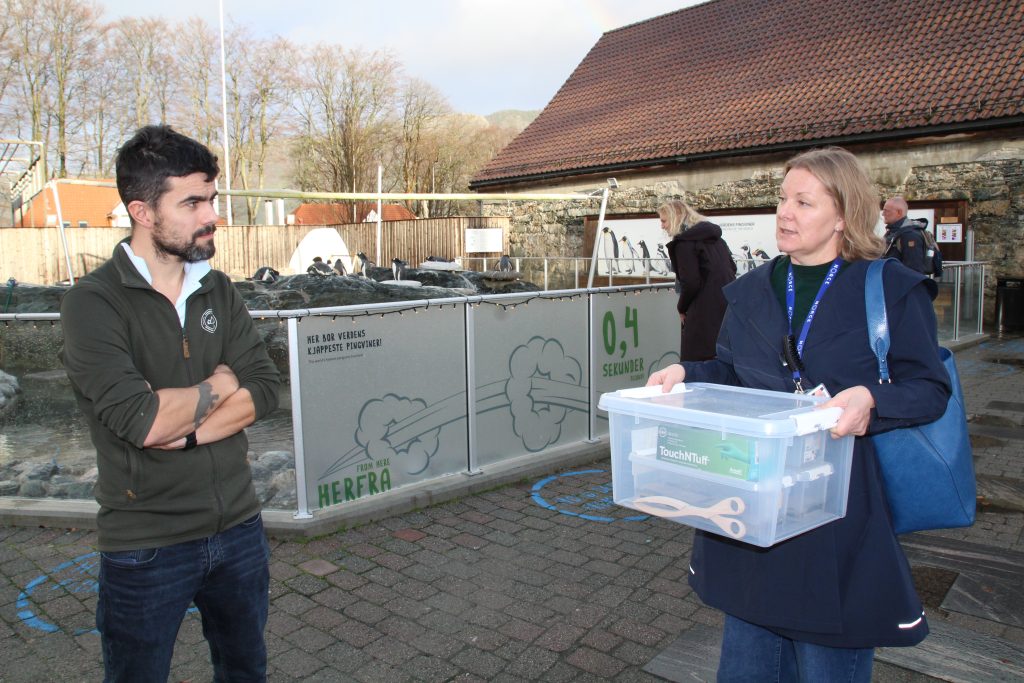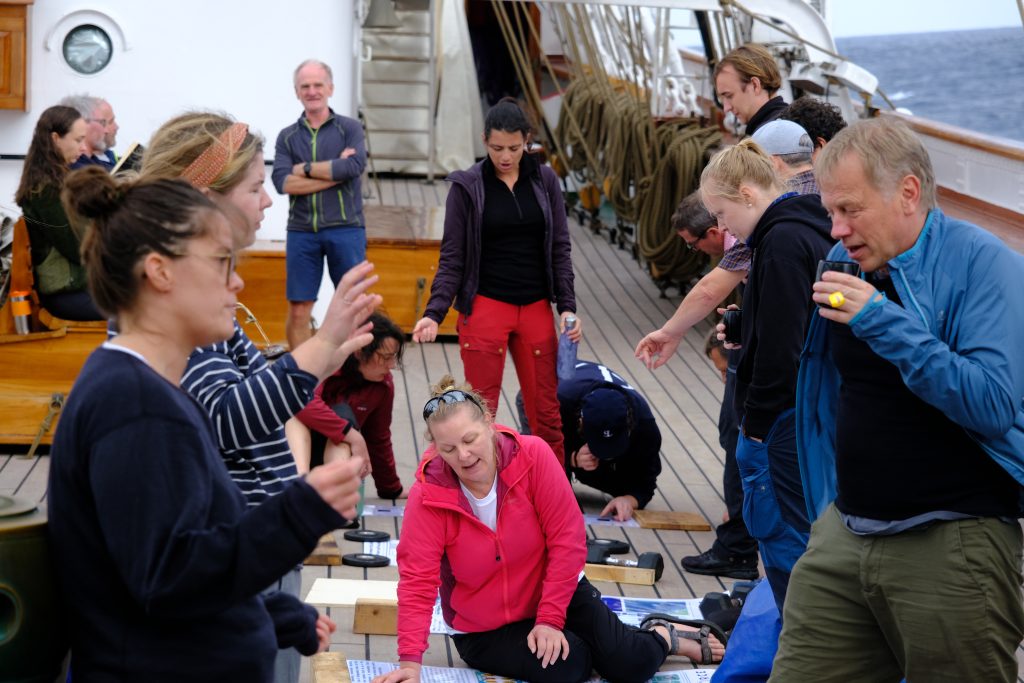Midway through the “biodegradable plastics breakdown” experiment at Bergen Aquarium, Norway, led by NORCE scientist Gunhild Bødtker, important and surprising discoveries are already coming to light.

NORCE scientist Gunhild Bødtker presented the findings of her “biodegradable plastics breakdown”-experiment at the Miami-New York leg of the One Ocean Expedition just before Christmas. Photo: Isak Okkenhaug/Statsraad Lehmkuhl
Gunhild Bødtker is a working group member and an author on the SAPEA report Biodegradability of plastics in the open environment. Following the publication of the report, Dr Bødtker set up an experiment at the Bergen Aquarium. In a tank at the aquarium, she is studying how long it takes for some specific kinds of biodegradable plastics to break down fully in a marine environment similar to the sea near Bergen in Norway.
She is also studying which microbes are involved, and whether the location of the samples makes any difference: some samples are in the water column, while others are on a sediment simulating the seafloor. The experiment has been running since summer 2021.
– You’ve been engaged in the biodegradability of plastics even before you took part in the working group of the SAPEA report?
– That’s correct. Many of the smaller islands on the western coast of Norway have an alarming amount of plastics pollution. We’ve had several projects at NORCE documenting this. Some of this work can be seen in the Norwegian documentary series “Plasthavet”, where some heavily polluted smaller islands also are being cleaned up by volunteers.
– I was interested in the biodegradability of conventional plastics before, knowing that biodegradability would be very slow. Looking at plastics produced to be biodegradable became more of a focus when I was working on the SAPEA report.
Different types of biodegradable plastics
In her experiment at the Bergen Aquarium, Gunhild Bødtker is studying the biodegradability of two different types of biodegradable plastics, compared to one positive and one negative control material. In addition, she is comparing how fast the materials biodegrade on the “seafloor” of the tank compared to materials floating freely in the tank. After 125 days, midway through the experiment, she’s already seeing some surprising results.

Ørjan Sælensminde at the Bergen Aquarium, and Gunhild Bødtker. Photo: Nils Olav Sæverås
– We’ve seen a much faster biodegradation of the Polyhydroxybutyrate (PHB) variant of biodegradable plastics than we expected. We’ve also seen that our positive control material, which was made from cellulose, has completely disappeared. This indicates a healthy presence of microorganisms contributing to the biodegradation of these types of material in Norwegian sea water.
Recent updates and comprehensive information about the experiment can be found on the website Built2biodegrade.
Findings on water temperature
– From our results so far, we have a clear indication that water temperature isn’t as essential to biodegradation rates in seawater as previously thought. It was commonly held that warmer waters, like the South Asian waters, would speed up biodegradation rates. From our results, it seems that the types of microorganisms present, in combination with other environmental factors, are more important.
Gunhild Bødtker is careful to emphasize that even though the results of the Bergen experiment suggest that temperature may not be the main factor determining environmental degradation rates of biodegradable plastics, more emphasis should be put on the combination of environmental factors within habitats and climate zones, as well as material type and sample history.
The experiment is a pilot study and Gunhild Bødtker hopes to set up a control experiment. Findings from the pilot study are already quite significant, particularly the findings on water temperature.
Another result of the experiment is that materials biodegraded at a faster rate on “sea floor” sediment than materials floating freely in the tank. This is in line with previous findings.
Dr Bødtker wants to be very clear that whatever conclusions are drawn from the experiment, littering is not acceptable, even with products made from biodegradable plastics.
– We know that certain products have a higher risk of ending up in the sea, such as fishing equipment. If some of these are made from biodegradable plastics, that might have an effect. But biodegradable plastics shouldn’t be an excuse for littering.
The Bergen experiment test pure polymers, while products made from these polymers will usually have added materials. The added materials will also need to be biodegradable if future biodegradability-certification processes are considered.

The Norwegian tall ship Statsraad Lehmkuhl serves as a floating university and training vessel combined. The Miami-New York leg of the ongoing expedition had a special focus on science. Photo: Isak Okkenhaug/Statsraad Lehmkuhl

Following the publication of the SAPEA report “Biodegradability of plastics in the open environment report”, Dr Bødtker set up an experiment at the Bergen Aquarium. Photo: Nils Olav Sæverås
She is now in the process of seeking funding for the next phase of the experiment. Bødtker says,
– It will be interesting to see how a different type of “seafloor” in the tank affects the biodegradation rate. Also, for the next experiment, it will be interesting to test actual products rather than just pure polymers.
In the latest update from the experiment, Bødtker and collaborators report that the biodegradation rate of PHB on the “seafloor” sediment of the Bergen Aquarium tank (11-12 degrees Celsius) is similar to what was previously observed onSE Asian marine sediment (29 degrees Celsius).
Experiment presented during One Ocean Expedition
Dr Bødtker has recently taken part in the One Ocean Expedition, where the Norwegian tall ship Statsraad Lehmkuhl is circumnavigating the globe. From August 2021 to April 2023, Statsraad Lehmkuhl is sailing 55,000 nautical miles and visit 36 ports worldwide. Gunhild Bødtker participated on the Miami-New York leg of the expedition just before Christmas. Statsraad Lehmkuhl serves as a floating university and training vessel combined, with University of Bergen as a major contributor. The leg Dr. Bødtker sailed had a special focus on science.
– We had a lot of interesting feedback when the experiment was presented on the One Ocean Expedition. For instance, many participants in the expedition were surprised to discover that bioplastics and biodegradable plastics are not the same thing, Bødtker says.
– This is an important research field. For me personally, it was quite an awakening that even though we were in the open sea, we could see plastics the water, emphasizing the need for more research and more sustainable solutions.
